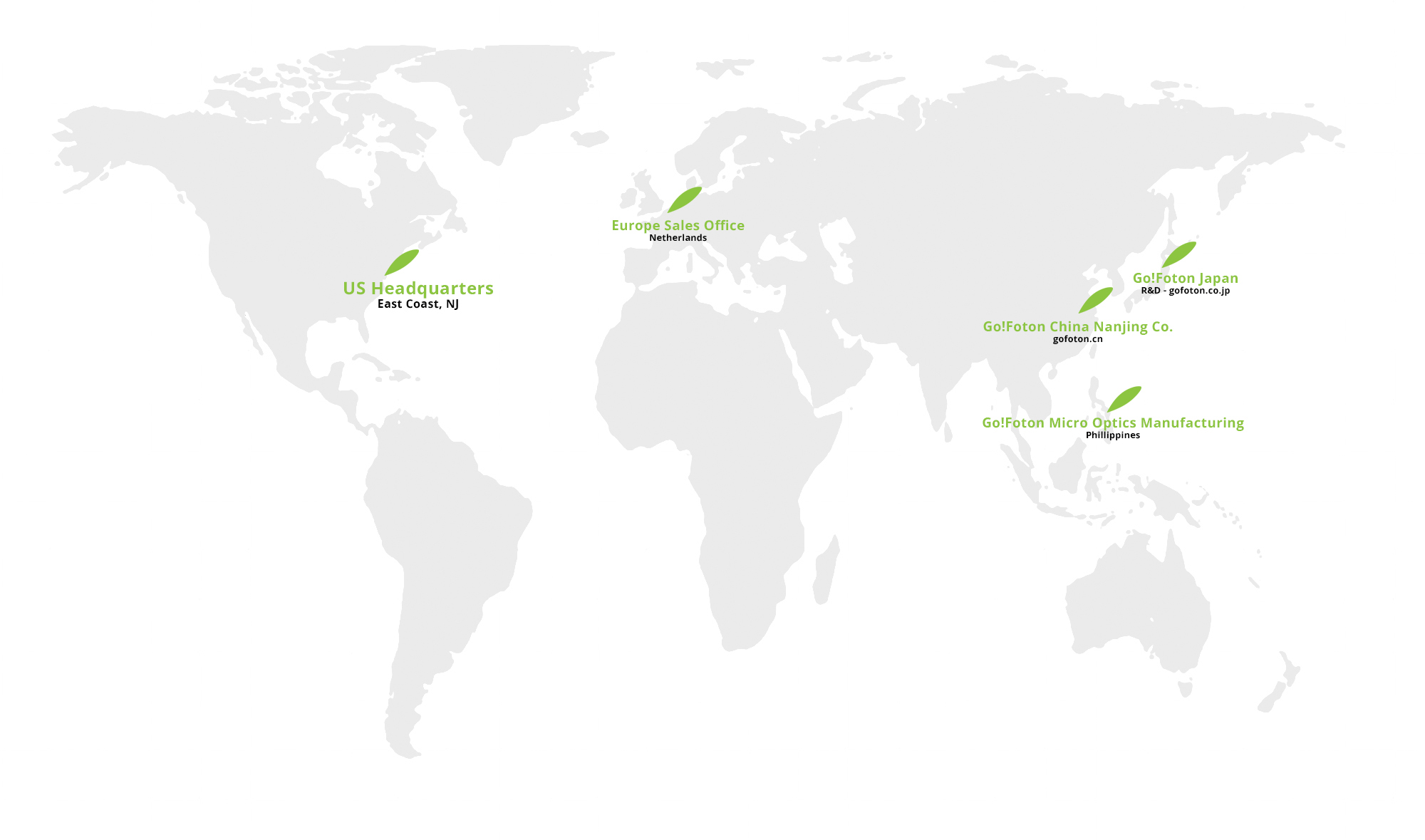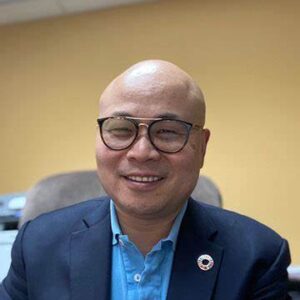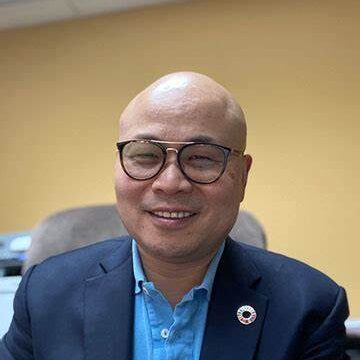Mission Statement
Our corporate mission
Help our customers solve complex business challenges which bring them a competitive advantage through our innovative solutions.


Expertise in optics and photonics
Bringing innovation and photonics together to solve real-world problems
More than just a manufacturer or distributor, we solve complex business challenges for our customers.
Driving optics and photonics innovation since 2009, Go!Foton is revolutionizing the fiber optic communications, medical imaging, and document reproduction industries by providing modern alternatives to conventional glass optics and fiber connectivity.
We bring light to life
Our vision is inspired by nature
We believe by following the nature and beauty of physics and mathematics, Go!Foton can advance optical network architectures that require the least amount of energy and use the purest materials.
Our vision is geodesic — Every day, we challenge ourselves to master the intimate interplay of time, space and light to create products and services that: bring light to life!
Since light and space/time were released shortly after the Big Bang, the Laws of Nature continue to hold clues on how scientists and engineers can use light to advantage. From fractals to Fibonacci Rules to hand design, we let Nature be our guide to discovery and transformation. Every opportunity we create is a breakthrough in usability (space), efficiency (energy), and manufacturing (matter).
Your one-stop-shop access to our global network
With offices in 6 countries and over 1,600 employees worldwide, Go!Foton is the photonics industry’s leading innovator — offering a vast, global network of resources and services to our customers. In leveraging our technical knowledge, research and development expertise and manufacturing leadership, Go!Foton can deliver value-added products and services at any stage of the development cycle.
Go!Foton has also developed long-standing relationships with the preeminent optical component, system and system integration companies that look to us for design and development, outsourcing, channel management, packaging and manufacturing services. Go!Foton offers manufacturing capabilities to our customers in various vertical markets together with the company’s design and development capabilities in micro optics. By leveraging our optical expertise and global reach, customers have “one-stop-shop” access for all their optical component manufacturing needs.

Partnering with the best
Go!Foton complements its “original” optical designs with specialized technology procured through partnerships with key industry leaders in areas such as thin film coating, fiber interface modules for PON technology, and other unique technologies. This approach enables us to offer a comprehensive “tool box” of component solutions in high growth areas in today’s marketplaces, such as broadband FTTx and PON networking, wireless backhaul infrastructure deployment, medical/biotech applications, etc.Go!Foton offers customers a vast, global network of resources and services. Customers can build their businesses by using our employees, facilities and intellectual property.
Our executive team
Simin Cai, Ph.D.
Founder, President & CEO
Dr. Simin Cai joined NSG America as a Regional Sales Manager in January, 1998. He worked in various sales, marketing, and business development positions before being promoted to President and Chief Operating Officer in 2001, and later Chief Executive Officer in 2005. In 2007, he was promoted to be the General Manager for NSG Group’s telecommunication business worldwide. In 2009, he led a management buyout and founded Go!Foton Group. Prior to joining NSG, Simin had worked for a couple of start-up companies involved in optics and optical instrumentation and participated in the founding of Avanex, now part of Lumentum after several mergers and acquisitions. Simin started his career with China International Trust and Investment Corporation (CITIC) in 1988.
Simin holds a BS degree in Applied Physics from Shanghai Jiao Tong University in Shanghai, China, a Master of Engineering degree in Engineering Optics and a Ph.D. degree in Physics, both from Stevens Institute of Technology in Hoboken, New Jersey.
David Z. Chen, Ph.D.
Chief Technology Officer
David has published many industry record breaking ULH field trial papers, and he has been granted numerous USA patents. At Verizon, he led the industry into the new Ultra-Bend-Insensitive fiber (G.657-B3) invention, improved new Dry-Filler based OSP cables, perfected Air-Jetted-Cable deployment for densely populated cities, contributed MDU drop to In-Living-Unit fiber cable design and related optical termination products. Jointly, David has been working with Telcordia and other industry leading optical fiber/system vendors in the multiple Telcordia GR based quality control/testing/standard documentation revisions. He also contributed to the industry on Space-Division-Multiplex technology development with multiple patents granted.
David holds a BS degree in precision mechanics and optical instrument from Shanghai Science and Technology University, two Master and a Ph.D. degree in Theoretical Physics with the focus on Quantum/Nonlinear Optics, Modern Chaos theory, and computational analysis for quantum stability and Higgs Boson from University of Texas at Dallas.
Timothy Badar
Vice President of Product Line Management, Interim General Manager of Passive Optical Solutions Business Unit
Tim brings strong Telecom and Datacom network and market experience from his previous Product Management and Business Development roles at TE Connectivity in next generation high-speed I/O connectors, fiber optic connectivity products, and passive optical devices. Tim holds several patents and has contributed industry papers on fiber optic components, optical inspection systems, and fiber network architectures. Previously, Tim held leadership roles in product development, product management, and business development in optical data storage and optical sensor/inspection technologies at CyberOptics, Seagate Technology and 3M.
Tim holds a BS degree in Physics from the University of Notre Dame, and an MS degree in Optics from the University of Rochester, and is currently based in Go!Foton’s San Jose, CA office.
Michael Zammit
Vice President and General Manager, Connectivity Solutions
An engineer by training, Michael is an accomplished global business development and telecom management executive with a broad perspective for identifying and growing strategic business opportunities. Most recently, Michael was Managing Director of the Network & Product Integrity Group at Telcordia Technologies where his lab team was responsible for developing and publishing performance requirements and standards for passive optical components as well as related outside plant, access network products and technologies. Prior to Telcordia, Michael was a founding member and Vice President of Advanced Broadband, LLC; a division of Toll Brothers, Inc (NYSE: TOL) which provided private broadband services to luxury gated communities and MDUs nationwide before its acquisition by Comcast. While at Toll Brothers, Michael was responsible for all aspects of business operations including the design, engineering, and construction of CATV and datacom headends as well as HFC and FTTH distribution networks.
Michael earned his BS and MS degrees in Mechanical Engineering from Columbia University and MIT, respectively.
Feng Tian, Ph.D.
Vice President and General Manager, Active Products
Feng has more than 25 years of experience in fiber optic communications. Most recently he was leading technical marketing development at Sumitomo Electric Device Innovations. Prior to that, he was DMTS at Motorola responsible for GPON development after Motorola acquired Quantum Bridge Communications, a startup qualified by Verizon for BPON system, where he was the chief optical scientist. His earlier career in fiber optics includes working experience in various countries including Canada, Germany, France, and China.
Feng earned his Ph.D and M.S. in Optical Fiber Communications from Beijing University of Posts and Telecommunications, and B.S. in Electrical Engineering from the University of Electronic Science and Technology of China in Chengdu, China.
Glenn Lu
Group Vice President, Global Manufacturing Operations, President, GF Micro Optics Philippines
Prior to joining NSG, Glenn served as Vice President of manufacturing and later Vice President of Global Manufacturing Operations at Oplink Communications, Inc. He started his career in the US with E-Tek Dynamics, now part of Lumentum, first as an R&D Engineer, later Manufacturing Engineer, and Production manager. He also participated in the founding of Avanex, now which is a part of Lumentum. Early in his career in China, he was an assistant professor in Physics at Shanghai Jiao Tong University.
Glenn received his BS in Applied Physics and M.S. in Fiber Optics from Shanghai JiaoTong University in Shanghai, China, and M.S. in Electrical Engineering from City College of New York of CUNY in New York City.
Mark Miller
Vice President of Sales
Mark brings a long history of sales experience to the Company after his 34 years of tenure at AT&T. He started as an engineer at AT&T after graduating from college and quickly moved to product management, then sales and business development. Prior to joining the Company, he retired from AT&T as a director of business development, leading collaborative efforts with AT&T sales teams and network architects targeting C-Suite executives at Fortune 500 companies.
Mark holds a BS degree in Electrical Engineering from Rutgers University.
GoFoton’s technology & innovation
PEACOC ® is Go!Foton’s Panel with Enhanced Access for Compact Optical Connectors for data center and telecom applications. The Go!Foton PEACOC platform boasts easy, tool-less access to 144 standard simplex or duplex LC terminations per 1RU for 19″ or 23″ racks , an industry first. Higher density fiber distribution frames allow telecom and data center providers to more efficiently and more cost effectively manage the explosive growth of fiber connections. The PEACOC frame is scalable in increments of just 1RU for true “pay as you grow” convenience and greater cost efficiency. With the option for integrated optical components such as xWDM, tap splitters, and NG-PON2 filters, PEACOC is the most compelling solution for all dense fiber applications.
A single, fully loaded 7ft frame can support up to 5760 fiber terminations using standard LC connectors. The port density can be increased even further with the use of smaller form factor connectors, or by using multi-fiber push-on (MPO) connectors. This novel design incorporates Go!Foton’s patent pending PEACOC technology, an innovative, “fat finger friendly” fiber jumper management solution that requires no special tools. Go!Foton’s PEACOC technology addresses the biggest drawback associated with the use of high density fiber distribution frames today, namely, difficulty in the convenient access and safe handling of the compact optical connectors to perform basic fiber jumper management operations.
With PEACOC technology, each individual optical connection can be easily isolated from adjacent optical connections providing a generous region of unobstructed handling space for safe, error free fiber management.
As the creators of the SELFOC ® Lens, NSG Group manufactures and distributes more gradient-index lenses than anyone else in the world. Developed over 30 years ago, the SELFOC ® Lens has revolutionized the industries of fiber optic communications, medical imaging, and document reproduction by providing a modern alternative to conventional glass optics. As the world’s first “self-focusing” lens. SELFOC ® is recognized worldwide as a unique, convenient, and economical solution to many optical design challenges. NSG Group and Go!Foton support this unique product technology with first-rate technical expertise and dependable customer service.
Go!Foton is the exclusive distributor of SML ® products for the optical communication market worldwide. Go!Foton also distributes information device products in North America and Europe.
To understand the nature of SELFOC ® lenses, knowing how the conventional lens works is fundamental to its deployment. A conventional glass lens can bend light only at its surfaces. At the interface between air and glass, rays of light will change direction according to the abrupt change in the index of refraction. By carefully controlling the shape and smoothness of the lens surfaces, these rays can be brought to a focus and form an image.
GRIN (GRadient INdex) lenses offer an alternative to the often painstaking craft of polishing curvatures onto glass lenses. By gradually varying the index of refraction within the lens material, light rays can be smoothly and continuously redirected towards a point of focus. The internal structure of this index “gradient” can dramatically reduce the need for tightly-controlled surface curvatures and results in a simple, compact lens geometry.
GRIN and SELFOC ® The key to gradient index technology lies in the controlled variation of the refractive index. This is achieved by a high-temperature ion exchange process within the glass host material. The SELFOC ® lens, manufactured and distributed by NSG America, is produced by a unique ion exchange process that yields stronger index gradients than any other method currently used in production.
With SELFOC ® technology, optical engineers and researchers have the ability to form a real image on the physical surface of a lens. This creates unique possibilities for coupling light into an optical fiber or relaying an image through an endoscope. The compact, cylindrical geometry makes it possible to put SELFOC ® lenses into arrays for document scanning or LCD imaging. With a variety of options including AR (Anti-Reflection) coating, metallization, and angled facets, SELFOC ® lenses may be customized to work for your application.
SELMUX ® is a patented technology that optimizes glass, epoxy and Filter-on-Lens (FOL) technologies to create integrated, Edge WDM couplers and components. This breakthrough eliminates soldering so all SELMUX ® products are completely lead free and comply with EU directives on the Restriction of Hazardous Substances or RoHS. SELMUX ® packaging technology now also covers all chip based thin film filter applications including wideband Wavelength Division Multiplexers (WDMs), Coarse WDMs, Dense WDMs, and Gain Flattening Filter (GFF) modules.
The SELMUX ® packaging platform boasts fewer constituent piece parts, fully compliant (6 of 6) to EU directives on the Restriction of Hazardous Substances (RoHS), qualified to Telcordia GR 1221 standards, and is the only field proven filter based WDM product capable of operating at -40°C to +85°C for rigorous outside plant (OSP) requirements.
The key material ingredient to Go!Foton’s SELMUX ® Platform is our expertise using FOL technology. FOL coatings that are deposited directly on the end face of the SELFOC ® GRIN lens to create a single integrated, monolithic device, rather than using separate filter substrates. This technique eases alignment, improves reliability and reduces cost by simplifying the manufacturing process. In addition, the integrated FOL process enables a flexible architecture to achieve high isolation and low insertion loss designs which is ideal for broadband applications. By expanding the coverage to include a broad range of chip based filters, the beneficial features of the SELMUX ® package are now available to the entire field of filter based component applications.
Dr. Yusuke Ota founded Zenko Technologies Inc. in 2002 after retiring from Agere Systems as CMTS. Zenko quickly became an innovative leader in burst-mode technologies for digital communications under Yusuke’s leadership. In 2010, Go!Foton acquired Zenko and Yusuke joined Go!Foton to serve as its CTO.
Prior to founding Zenko, Yusuke had a stellar career of about 30 years with Bell Laboratories, first with AT&T, later Lucent before joining Agere Systems. He initiated the Si molecular beam epitaxy technology and succeeded in growing dislocation-free epitaxial films for the first time in the world. He is also referred to as “Father of Si MBE”. In 1983, he became a member of a task force for developing InP based optoelectronic devices such as InGaAs PIN photodiodes and InGaAsP LED/LD. He received the title of Distinguished Member of Technical Staff (DMTS) in 1983. He invented parallel optical data links and many electronics associated with optical communications. During this period, Yusuke was involved in the material development of optical fibers and study of optical loss. He was also heavily involved the development of alignment technique between optical fiber and active devices. These contributions are really part of the foundation of today’s optical communications industry.
In 1988, he and his colleagues introduced the concept of burst mode optical communication for optical data links. They succeeded to fabricate burst mode receiver IC using Si bipolar IC technology. They also developed a 40-channel parallel optical data link (MODLINK) for future ATM switching systems. Even at the present time, no other parallel optical data link can match with this system. The technology of burst-mode optical communication, which Yusuke invented, actually triggered today’s passive optical networks (PON). Yusuke has been a leader in the field of optical data communications in many aspects.
Yusuke received BS and MS in electronics engineering both from Shizuoka University, Japan, and a Ph.D. degree from the University of Pennsylvania, Philadelphia, PA.
The Fiber!FAST ™ Indoor Living Unit (ILU) Solutions. Fiber!FAST ™ ILU is an innovative MDU drop cable solution that allows service providers to bring FTTH service to existing MDU living units in a faster and easier fashion. Fiber!FAST ™ ILU reduces a carrier’s installation costs and minimizes the disruption and aesthetic objections often associated with retrofitting service cables in existing MDU living units.
Fiber!FAST ™ ILU consists of a new 900um drop cable with G657.B3 fiber, the most advanced bend optimized fiber manufactured by Samsung Electronics. The translucent Fiber!FAST ™ cable is easily attached to a variety of wall surfaces using simple and discrete plastic clips. Designed and manufactured by Go!Foton, the pathway management toolkit provided with Fiber!FAST ™ ILU includes a variety of these clips along with a small tube of specially formulated epoxy which can be applied at discrete points along the cable or smeared like painters caulk, resulting in a truly invisible installation that may be painted by the homeowner if desired.
The unique design of Fiber!FAST ™ also provides exceptional mechanical protection when routing the optical drop cable around inside and outside corners. Often missing from other MDU cable solutions, corner protection prevents excessive bending and the formation of stress points on the cable.
The Gradient Constant
The SELFOC
® lens utilizes a radial index gradient. The index of refraction is highest in the center of the lens and decreases with radial distance from the axis. The following equation describes the refractive index distribution
of a SELFOC
® lens:
Equation 1:
N(r) = N0(1 – √A2/ 2 * r2)
This equation shows that the index falls quadratically as a function of radial distance. The resulting parabolic index distribution has a steepness that is determined by the value of the gradient constant, √A. Although the
value of this parameter must be determined through indirect measurement techniques, it is a characterization of the lens’ optical performance. How rapidly rays will converge to a point for any particular wavelength depends
on the gradient constant. The dependence of √A and N0, on wavelength is described by the dispersion equations listed at the end of this product guide. Note that different dispersion equations apply to different lens diameters
and numerical apertures.
Lens Length & Pitch
In a SELFOC
® lens, rays follow sinusoidal paths until reaching the back surface of the lens. A light ray that has traversed one pitch has traversed one cycle of the sinusoidal wave that characterizes that lens. Viewed in
this way, the pitch is the spatial frequency of the ray trajectory.
Equation 2:
2πP=√AZ
The above equation relates the pitch (P) to the mechanical length of the lens (Z) and the gradient constant. The figure below illustrates different ray trajectories for lenses of various pitch. Notice how an image may be
formed on the back surface of the lens if the pitch is chosen appropriately.
Paraxial Optics
In contrast to the optics of homogeneous materials, gradient-index optics involve smoothly-varying ray trajectories within the GRIN media. The paraxial (first-order) behavior of these materials is modeled by assuming sinusoidal
ray paths within the lens and by allowing the quadratic term in Equation 1 to vanish in the ray-tracing calculations. All of the usual paraxial quantities may be calculated with the help of the ray-trace matrices given at
the end of this product guide. The formulae for common paraxial distances have also been tabulated for quick reference.
Our history
Would you like to hear more?
Our experts would love to hear about your systems and how we can help



